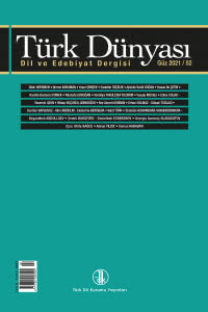MÖHEMMET MEHDİYEV’İN TURNALARIN İNDİĞİ YERDE ADLI ROMANINDA KAZAN TATAR GELENEKLERİ
Köklü bir geçmişe ve zengin bir kültüre sahip olan Kazan Tatarlarının
Anahtar Kelimeler:
Kazan Tatarları, Kazan Tatar gelenekleri, Kazan Tatar edebiyatı, Saban Toyu, Möhemmet Mehdiyev, Tornalar Töşken Cirde
Kazan Tatar Traditions in Möhemmet Mehdiyev’s The Place Where Cranes Land Novel
The life of Kazan Tatars, whose long standing history, culture andtheir country life descriptions are written in detail by Möhemmet Mehdiyevin his “Tornalar Töşken Cirde” (The Place Where Cranes Land) novel.In his novel, he mentioned Tatar’s national holiday Saban Toyu (PlowCelebrations), which roots back to hundreds of years ago, and some localand domestic traditions. Saban Toyu is still celebrated among Tatars eventoday. Although theme of this holiday changed in years, it did not loseits roots and national importance. Some Tatar traditions differing fromone city to another and even differ from town to town, became a localcelebration ritual. For example, “Cilek Cıyu” (Collecting Strawberries)is carried out in towns where strawberries are planted, while “Şel Beylev”(Scarf Knitting) is carried out where goats are. On the other hand,“Soldatka Ozatu” (Farewell to the Soldiers) is carried out in every townwhere Tatars live, because every young man reaching 18 years of age isobliged to military service. Möhemmet Mehdiyev also mentions KazanTatar family traditions in his novel. He mentioned that these traditionsnot only gather family together but also they have effects on a person’slife. Considering that some nearly faded traditions are mentioned in hisnovel, makes his novel important in terms of understanding Kazan Tatars.As an example to these faded traditions; “Avlak Öy” (Desolate House)can be considered. According to this tradition, the youngsters of the townmeet in one of their friend’s house in the autumn and in the winter months.Since these traditions are not continued anymore, the only ones whoknow them are old people, which also fade away as time passes. The newgeneration can learn about these old traditions from novels. Traditionsare the bridges between the past and the future, which enables a nationto keep its identity.
Keywords:
Kazan Tatars, traditions of Kazan Tatars, Kazan Tatar literature, Saban Toyu, Möhemmet Mehdiyev, Tornalar Töşken Cirde (The Place Where Cranes Land),
___
- Bayazitova, F. (1997). Kéreşénner. Tél Üzénçelékleré hem Yola İcatı (Kereşenler (Hristiyanlaştırılmış Tatarlar). Dil Özellikleri ve Gelenekleri). Kazan: Matbugat Yortı.
- Kerimullin, E. (1991). Tatarlar: İsémébéz hem Cisémébéz (Tatarlar: Adımız ve Sanımız. Kazan: Tatarstan Kitap Neşriyatı.
- Kurban, R. (2015). “Memleketine Mehdiye Düzen Tatar Yazar Möhemmet Mehdiyev -I”, Töre Dergisi. 31-32, 31-38.
- Kurban, R. (2016). “Memleketine Mehdiye Düzen Tatar Yazar Möhemmet Mehdiyev -II”, Töre Dergisi. 33, 32–34.
- Kurban, R. (2017a). “Kazan Tatarlarının Milli Bayramı Saban Toyu’nun Dünü ve Bugünü-I”, Önce Vatan Gazetesi. 18 Ağustos, 11.
- Kurban, R. (2017b). “Kazan Tatarlarının Millî Bayramı Saban Toyu’nun Dünü ve Bugünü- II”, Önce Vatan Gazetesi. 19 Ağustos, 11.
- Mehdiyev, M. (1995). Saylanma Eserler (Seçkiler). 1.Cilt, Kazan: Tatarstan Kitap Neşriyatı.
- SSCB Bilimler Akademisi Kazan Şubesi Galimcan İbrahimov Dil, Edebiyat ve Tarih Enstitüsü (1977). Tatar Télénéñ Añlatmalı Süzlégé (Tatar Dilinin İzahlı Sözlüğü). 1, Kazan: Tatarstan Kitap Neşriyatı.
- SSCB Bilimler Akademisi Kazan Şubesi Galimcan İbrahimov Dil, Edebiyat ve Tarih Enstitüsü (1981), Tatar Télénéñ Añlatmalı Süzlégé (Tatar Dilinin İzahlı Sözlüğü). Cilt: 3, Kazan: Tatarstan Kitap Neşriyatı.
- TDK (2005). Türkçe Sözlük. Ankara: TDK Yayınları.
- Urazman, R. (1992). Tatar Halkının Yolaları hem Beyremneré (Tatarların Gelenekleri ve Bayramları). Kazan: Tatarstan Kitap Neşriyatı.
- ISSN: 1301-0077
- Yayın Aralığı: Yılda 2 Sayı
- Başlangıç: 1996
- Yayıncı: Türk Dil Kurumu
Sayıdaki Diğer Makaleler
TÜRKMEN TÜRKÇESİNDE DUDAK BENZEŞMESİ (LABIAL SINGARMONIZM)
İZMİR İLİ ÖDEMİŞ-KİRAZ-BEYDAĞ İLÇESİ AĞIZLARININ TEMEL ÖZELLİKLERİ
1944 SÜRGÜNÜ SONRASI ÖZBEK TÜRKÇESİNDEN KIRIM TATAR TÜRKÇESİNE GEÇEN KELİMELER ÜZERİNE BİR İNCELEME
TURFAN BÖLGESİNDEKİ ESKİ UYGUR YER ADLARI
MÖHEMMET MEHDİYEV’İN TURNALARIN İNDİĞİ YERDE ADLI ROMANINDA KAZAN TATAR GELENEKLERİ
KIRGIZ KÜLTÜRÜNDE KUT KAVRAMININ ÖZELLİKLERİ
